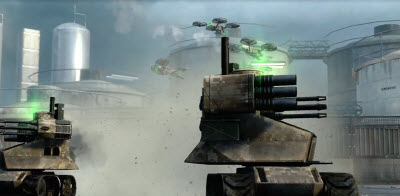The team that created the sounds for the upcoming Call of Duty: Black Ops II game spent an awful lot of time in the audio lab pictured above. To create the noises of the futuristic combat game, they had to spend time indoors making up sounds that didn’t exist in the real world.
Brian Tuey (pictured middle), audio director at Treyarch (the Activision Blizzard game studio that is making Black Ops II), said in an interview with GamesBeat that “going into the near future with this game meant something completely different.” Making new sounds is all part of trying to bring innovation to a game series such as Call of Duty which has had many iterations that took place in the past.
Normally, the team could go to the gun range to capture the reports of weapons, but it’s not so easy to capture the sound of a skyscraper collapsing.
“We soon realized the directions are limitless,” said Chris Cowell (pictured right), lead sound designer at Treyarch in Santa Monica, Calif.
 The team was resourceful and relied on cheap creations. They created an oscillator (pictured in the middle) that you could touch and short-circuit to produce different kinds of crazy sounds.
The team was resourceful and relied on cheap creations. They created an oscillator (pictured in the middle) that you could touch and short-circuit to produce different kinds of crazy sounds.
A walking mech-like robot, the Claw (pictured right), is one example of a weapons system that doesn’t exist in the real world. So the team manufactured a sound that the robot makes when walking around. That’s why they spent about 60 percent of their time in the second year of development making artificial sounds in the lab.
“We still go out in the field and record things,” said Shawn Jimmerson (pictured left), sound designer.
Tuey said, “It was really important to us that we are not science fiction. We are taking some liberties with the sounds of the near future, but we get there through reasoning.”
For instance, the Claw has a bunch of loud sirens on it. The reason is that it is used as a psychological warfare device. The big robot can scare the living daylights out of enemy soldiers, so it should have loud sirens on it.
“A lot of our decisions are driven by the plausibility,” Tuey said. “We think about the history that happened so that the device got to where it is in the game.”
 Jimmerson said that they captured some sounds by putting metals on dry ice to make the noise of metal bending. They used that to create the sound of girders snapping in a collapsing skyscraper.
Jimmerson said that they captured some sounds by putting metals on dry ice to make the noise of metal bending. They used that to create the sound of girders snapping in a collapsing skyscraper.
“It saves on the budget, so you don’t have to destroy a building,” Jimmerson said.
The team also works with musicians such as Jack Wall, who is creating the main soundtrack for the game. The story is very character driven, and the music has been tailored to each character.
One of the challenges is that the audio is layered in a cacophony of sounds. You have a musical score playing, the sound of gunfire, and background sounds such as an explosion or a mortar round going off.
“We have to make all of those things sound huge,” Cowell said. “We want a greater dynamic range of sounds. Each event itself sounds big. A gun sound coupled with a building falling down creates a much bigger sonic event. You will feel like it can’t possibly get any louder and then it does.”
The sound is also different for a gun when it is fired in a hallway or when it is outdoors.
“That really changes the character of the sound,” Cowell said.
In multiplayer, some of the sounds have to be different. You have to hear the sound of a bouncing grenade in order to get the audio cue to get the hell out of the spot where you’re hiding.
“We start with reality, and if the real sound is a disappointment, we beef it up,” Jimmerson said.
Check out our other coverage of Call of Duty: Black Ops II:
- First trailer released
- Treyarch unveils Black Ops II, a.k.a. Attack of the Drones
- Treyarch studio head Mark Lamia on taking design risks (interview)
- It’s not the same old 3D graphics
- How Treyarch created realistic human faces
![]() GamesBeat 2012 is VentureBeat’s fourth annual conference on disruption in the video game market. This year we’re calling on speakers from the hottest mobile, social, PC, and console companies to debate new ways to stay on pace with changing consumer tastes and platforms. Join 500+ execs, investors, analysts, entrepreneurs, and press as we explore the gaming industry’s latest trends and newest monetization opportunities. The event takes place July 10-11 in San Francisco, and you can get your early-bird tickets here.
GamesBeat 2012 is VentureBeat’s fourth annual conference on disruption in the video game market. This year we’re calling on speakers from the hottest mobile, social, PC, and console companies to debate new ways to stay on pace with changing consumer tastes and platforms. Join 500+ execs, investors, analysts, entrepreneurs, and press as we explore the gaming industry’s latest trends and newest monetization opportunities. The event takes place July 10-11 in San Francisco, and you can get your early-bird tickets here.
VentureBeat's mission is to be a digital town square for technical decision-makers to gain knowledge about transformative enterprise technology and transact. Learn More

